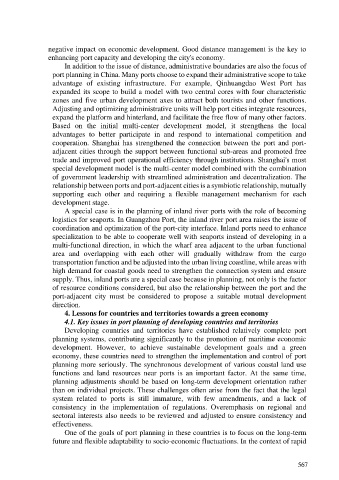Page 575 - Ebook HTKH 2024
P. 575
negative impact on economic development. Good distance management is the key to
enhancing port capacity and developing the city's economy.
In addition to the issue of distance, administrative boundaries are also the focus of
port planning in China. Many ports choose to expand their administrative scope to take
advantage of existing infrastructure. For example, Qinhuangdao West Port has
expanded its scope to build a model with two central cores with four characteristic
zones and five urban development axes to attract both tourists and other functions.
Adjusting and optimizing administrative units will help port cities integrate resources,
expand the platform and hinterland, and facilitate the free flow of many other factors.
Based on the initial multi-center development model, it strengthens the local
advantages to better participate in and respond to international competition and
cooperation. Shanghai has strengthened the connection between the port and port-
adjacent cities through the support between functional sub-areas and promoted free
trade and improved port operational efficiency through institutions. Shanghai's most
special development model is the multi-center model combined with the combination
of government leadership with streamlined administration and decentralization. The
relationship between ports and port-adjacent cities is a symbiotic relationship, mutually
supporting each other and requiring a flexible management mechanism for each
development stage.
A special case is in the planning of inland river ports with the role of becoming
logistics for seaports. In Guangzhou Port, the inland river port area raises the issue of
coordination and optimization of the port-city interface. Inland ports need to enhance
specialization to be able to cooperate well with seaports instead of developing in a
multi-functional direction, in which the wharf area adjacent to the urban functional
area and overlapping with each other will gradually withdraw from the cargo
transportation function and be adjusted into the urban living coastline, while areas with
high demand for coastal goods need to strengthen the connection system and ensure
supply. Thus, inland ports are a special case because in planning, not only is the factor
of resource conditions considered, but also the relationship between the port and the
port-adjacent city must be considered to propose a suitable mutual development
direction.
4. Lessons for countries and territories towards a green economy
4.1. Key issues in port planning of developing countries and territories
Developing countries and territories have established relatively complete port
planning systems, contributing significantly to the promotion of maritime economic
development. However, to achieve sustainable development goals and a green
economy, these countries need to strengthen the implementation and control of port
planning more seriously. The synchronous development of various coastal land use
functions and land resources near ports is an important factor. At the same time,
planning adjustments should be based on long-term development orientation rather
than on individual projects. These challenges often arise from the fact that the legal
system related to ports is still immature, with few amendments, and a lack of
consistency in the implementation of regulations. Overemphasis on regional and
sectoral interests also needs to be reviewed and adjusted to ensure consistency and
effectiveness.
One of the goals of port planning in these countries is to focus on the long-term
future and flexible adaptability to socio-economic fluctuations. In the context of rapid
567

